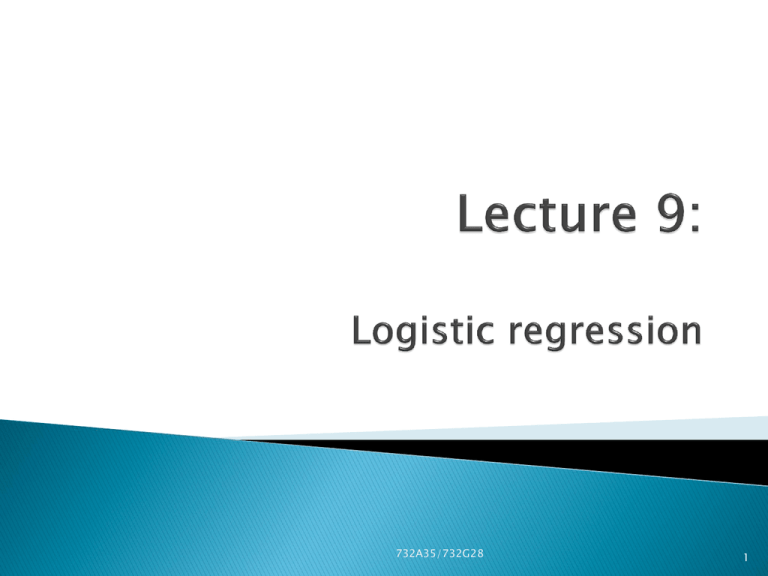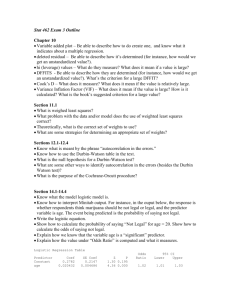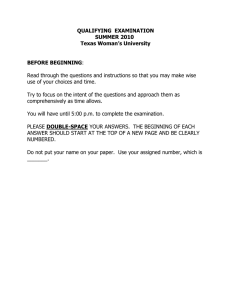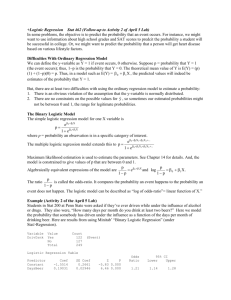1 732A35/732G28
advertisement

732A35/732G28 1 Before, we considered qualitative predictors dummy variables Now, qualitative responses Plan: Regression with binary response Simple logistic regression Multiple logistic regression Ordinal logistic regression Nominal logistic regression 732A35/732G28 2 Binary response: Y:Mortality=(Died, Alive). X1:tobacco exposure X2:age Binary response: Y:Borrower=(Yes, No) X1:Income, X2:Age, X3: Marital status,… Ordinal response: Y:Number of falls (older people, per 6 month) X1:gender, X2:Strength index, X3: Balance index Nominal response: Y:Consumer choice (product A, product B, product C) X1:Age, X2 gender, X3: Salary… 732A35/732G28 3 Straightforward idea: Simple regression model Yi 0, 1 Yi 0 1 X i i Bernoulli response Yi 1 0 Probability P(Yi = 1) = P(Yi = 0) = 1 - E(Y)=𝜋 732A35/732G28 4 Problems 1. 2. Nonnormal errors: ◦ When Yi = 1 i 1 0 1 X i ◦ When Yi = 0 i 0 1 X i Nonconstant error variance 2 i 2 Yi i 1 i 0 1 X i 1 0 1 X i Constraints on response 0 E (Y ) 1 Linear function will not work, need to restrict domain (plot the response) 3. 732A35/732G28 5 Model Yi EYi i exp( 0 1 X i ) EYi i 1 exp( 0 1 X i ) EYi Typical logistic regression function 1 0.9 0.8 1 0.7 1 exp( 0 1 X i ) 0.6 0.5 Logit transformation FL1 i ln i 1 i Odds i 1 i 0.4 0.3 0.2 0.1 0 -10 -8 -6 -4 -2 0 732A35/732G28 2 4 6 8 10 6 By using maximum likelihood (instead of least squares) ◦ Method maximizes a likelihood function L(data,β0,β1) and thus finds estimates of parameters ◦ L measures how suitable β0,β1 for given data ◦ In general, computer-intensive optimization methods required (logistic regression in particular) Predicting new observation: If predicted value πh>0.5 predict 1 otherwise 0 732A35/732G28 7 Interpretation of b1: ˆ ' X i b0 b1 X i ln i 1 ˆ i Look at ' X i 1 ' X i odds2 b1 ln odds1 b1 is logarithm of odds ratio 𝑒 𝑏1 𝑜𝑑𝑑𝑠2 = = 𝑂𝑅 𝑜𝑑𝑑𝑠1 732A35/732G28 8 25 computer programmers with different experience have performed a test. For each programmer we have recorded whether he or she passed the test (Y = 1) or not (Y = 0). Task success (Y) 14 0 29 0 6 0 25 1 . . . . 8 1 1 Success in task (Y) Months of experience (X) 0,5 0 0 10 20 30 40 Months of experience (X) 9 Binary Logistic Regression: Task success (Y) versus Months of experi Link Function: Logit Response Information Variable Value Count Task success (Y) 1 11 0 14 Total 25 (Event) Logistic Regression Table 95% Odds Predictor Coef SE Coef Z P Constant -3.05970 1.25935 -2.43 0.015 Months of experience (X) 0.161486 0.0649801 2.49 0.013 CI Ratio Lower 1.18 1.03 Upper 1.33 Log-Likelihood = -12.712 Test that all slopes are zero: G = 8.872, DF = 1, P-Value = 0.003 Goodness-of-Fit Tests Method Chi-Square DF P Pearson 19.6226 17 0.294 Deviance 19.8794 17 0.280 5.9457 8 0.653 Hosmer-Lemeshow 10 Success in task (Y) 1 0,5 0 0 5 10 15 20 25 30 35 Months of experience (X) 11 Our example: exp(0.1615) = 1.175 Interpretation: the odds for a programmer to succeed the task increases by 17.5% for each extra month of experience. Predict the probability that a programmer with 12 months experience succeeds the task. 732A35/732G28 12 Model Yi EYi i EYi i exp( 0 1 X i1 ... p 1 X i , p 1 ) 1 exp( 0 1 X i1 ... p 1 X i , p 1 ) EYi 1 1 exp( X' β) Logit transformation X' β ln i 1 i Typical multiple logistic regression plot Odds 1 0.8 0.6 0.4 0.2 0 10 10 5 5 i 1 i 0 0 -5 -5 -10 732A35/732G28 -10 13 Variance-covariance matrix estimated as Hessian of Likelihood estimated at b This is a computer routine Wald Test: Test about single βk Ho : k 0 Test bk Step 1: compute Z sb k Step 2: Plot the distribution , mark the points z(1-α/2) and the critical area. Step 3: define where Z is and reject H0 if it is in the critical area H a : k 0 732A35/732G28 14 Likelihood Ratio Test H0: βq = βq+1= ...= βp-1 = 0 Ha: not all β in H0 are zero 1 F Full model: 1 exp( X' β F ) 1 Reduced model R 1 exp( X' β R ) L( R ) Test statistics: G 2 2 ln L( F ) Decision rule: If G 2 2 (1 , p q) , conclude Ha 732A35/732G28 15 Months of experience Task success Age Sex 14 0 44 0 29 0 45 0 6 0 52 1 25 1 48 1 18 1 22 0 4 0 19 0 18 0 20 0 12 0 42 1 22 1 21 0 6 0 19 1 30 1 24 1 11 0 48 0 30 1 31 1 5 0 18 1 20 1 49 0 13 0 22 1 9 0 41 1 32 1 58 0 24 0 29 1 13 1 29 0 19 0 35 0 4 0 54 0 28 1 24 0 22 1 57 0 8 1 32 1 gathered information about programmers age and their sex as well. 732A35/732G28 16 Binary Logistic Regression: Task success versus Months of ex, Age, Gender Link Function: Logit Response Information Variable Value Count Task success 1 11 0 14 Total 25 (Event) Logistic Regression Table Predictor Constant Months of experience Age Gender Coef -2.53002 0.163344 -0.0091584 -0.358858 SE Coef 2.09690 0.0661327 0.0408756 1.10029 Z -1.21 2.47 -0.22 -0.33 P 0.228 0.014 0.823 0.744 Odds Ratio 1.18 0.99 0.70 95% CI Lower Upper 1.03 0.91 0.08 1.34 1.07 6.04 Log-Likelihood = -12.650 Test that all slopes are zero: G = 8.996, DF = 3, P-Value = 0.029 Goodness-of-Fit Tests Method Chi-Square Pearson 24.8743 Deviance 25.3007 Hosmer-Lemeshow 7.4477 DF 21 21 8 P 0.253 0.234 0.489 Test β1 = 0 Compute 95 % interval for β1 Test whether β2 =β3=0 17 Nominal Response 1. Code c categories 1..c 2. Coding : c categories, c-1 response variables 1, case i response is category j Yij 0, otherwise 3. Model (one category – reference, others give C-1 sets of βs) ij exp X i ' β j C 1 1 exp X i ' β k k 1 732A35/732G28 18 Ordinal response 1. Code categories 1..C 2. Assumed order, i.e. category 1<category 2 Model (one slope β without β0, C-1 intercepts α1… αC-1) PYi j 1 1 exp( j Xi ' β) Comments: Nominal logistic regression can be used for ordinal data, but ordinal regression should be more precise and easy to interpret Estimation=Maximum likelihood 732A35/732G28 19 Suppose you are a field biologist and you believe that adult population of salamanders in the Northeast has gotten smaller over the past few years. You would like to determine whether any association exists between the length of time a hatched salamander survives and level of water toxicity, as well as whether there is a regional effect. Survival time is coded as 1 if < 10 days, 2 = 10 to 30 days, and 3 = 31 to 60 days. 3,5 3 Survival 2,5 2 1,5 1 0,5 0 0 20 40 60 80 Toxic level 20 Nominal Logistic Regression: Survival versus ToxicLevel Response Information Variable Survival Value 3 2 1 Total Count 12 46 15 73 (Reference Event) Logistic Regression Table Predictor Logit 1: (2/3) Constant ToxicLevel Logit 2: (1/3) Constant ToxicLevel Coef SE Coef Z P Odds Ratio 95% CI Lower Upper -6,50972 0,195767 2,77595 0,0717625 -2,35 2,73 0,019 0,006 1,22 1,06 1,40 -10,9783 0,268063 3,19125 0,0788227 -3,44 3,40 0,001 0,001 1,31 1,12 1,53 Log-Likelihood = -57,937 Test that all slopes are zero: G = 17,420, DF = 2, P-Value = 0,000 Goodness-of-Fit Tests Method Pearson Deviance Chi-Square 266,244 87,239 DF 106 106 P 0,000 0,908 732A35/732G28 21 Ordinal Logistic Regression: Survival versus ToxicLevel Link Function: Logit Response Information Variable Value Count Survival 1 15 2 46 3 12 Total 73 Logistic Regression Table Odds Predictor Coef SE Coef Z P Const(1) -6.86978 1.61172 -4.26 0.000 Const(2) -3.35691 1.40131 -2.40 0.017 ToxicLevel 0.119939 0.0337103 3.56 0.000 95% CI Ratio Lower Upper 1.13 1.06 1.20 Log-Likelihood = -59.374 Test that all slopes are zero: G = 14.546, DF = 1, P-Value = 0.000 Goodness-of-Fit Tests Method Chi-Square DF P Pearson 113.052 107 0.326 Deviance 90.113 107 0.880 22 Ch14: 14.1, 14.2 but only logistic mean response function. 14.3 but not likelihood functions. 14.4 but not Fitting a model 14.5 14.11 but nothing about likelihoods. 14.12 but nothing about likelihoods 14.14 briefly. 732A35/732G28 23






